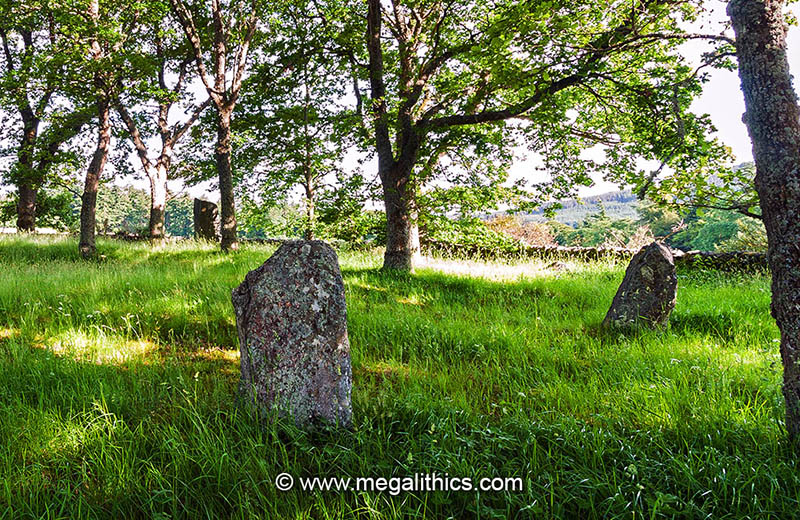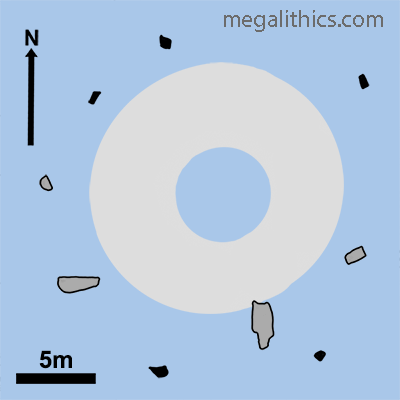 |
| NJ 18307 36406 (GPS 14min) Centre. | Diameter - 14m Cairn (Pub.), 22.7m Stone Circle (Est.) |
| Visited June 2010 | Alt.192m OD (GPS) |
 |
Marionburgh ( BAN 3 ), is a ruined Clava Cairn situated on level land near to Ballindalloch Castle. The River Avon flows past 300m to the SW and the A95 is only 200m to the East. The monument is presently in stone-walled enclosure and is protected from livestock.

PUBLISHED ACCOUNTS
Marionburgh is mentioned in the Old
Statistical account
(1)
" a short way up from the house of Ballendalloch, a few long stones inclosing a
small piece of ground, which was said to be a Druidical temple. The most of the
stones have been taken away, except one very broad, thick and long stone, which
stands still there". We can only think that Sinclair was referring to the
absence of kerb stones as nearly all of the large circle stones remain.
The inimitable Fred Coles visited and published
(2)
a description and detailed plan of the site in 1907, but unfortunately did not
include one of his wonderful customary sketches. He evidently had similar
problems recording the site due to vegetation as we had, "the interior is an
utter wilderness of weeds and luxuriant raspberry bushes, which almost
completely overgrow the fallen Stones and conceal more than half of those still
standing, so that it is impossible to obtain an entire view of the Circle from
any one point."
Marionburgh is, of course, covered in Henshall's magnum opus (3) saying that it is probable that "the remains are those of a passage-grave or ring-cairn". She also describes finding a possible outer kerb stone on the West side, but we could not locate this during our visit.
Barnatt (4) speculates that Marionburgh may be the remains of a Recumbent Stone Circle, citing the lack of kerb stones as evidence, although this suggestion is not widely accepted.
Welfare (5) includes Marionburgh in the extended gazeteer of his book, and comments on Barnatt's "lack of kerbs" RSC suggestion - "This is not a sound basis for such a suggestion and only serves to confuse the unwary."
We could find no reference of any excavations at the site in any of the above works, and presume it is still unexcavated.
THE CAIRN STRUCTURE
The cairn is presently situated in a stone-walled enclosure by the driveway to Ballindalloch farm, the whole site is riddled with substantial trees. These trees, and their foliage combined with the long grass, frustrated our attempts to take overall photos of the site and visitors will similarly find it difficult to envisage the original structure. We felt a fellowship with Fred Coles who had similar problems during his visit in 1907.
The cairn is 14m in diameter with a hollow in the centre that is interpreted as the original internal space at about 5m diameter. Published figures show a height of 0.6m for the cairn annulus, but with all of the tree growth within the site, this was not readily apparent to us during our visit. Henshall (3) describes finding a possible ?outer kerb stone at the site, but we could not spot it. In any event, no other kerbs are reported and this led Barnatt to speculate that the site was the remains of a Recumbent Stone Circle, an idea not shared by anyone else that we read. The central open space seems to be a little off-centre relative to the cairn's circle, being shifted to the SE.
The most striking feature of the monument today are the remnants of the stone circle that once surrounded the cairn. Of an original 11-12 stones, 9 remain and 5 of these are still standing. The circle shows the usual Clava height grading, with the tallest stones at the SW. The present tallest stone is at the SSW and is 2.75m tall, two approximately 1m high stones stand at the NW, another 1m stone is currently built into the enclosing wall at the West and the smallest stone stands hard against the wall at the SSE, it is only 0.7m high. Two large fallen stones bracket the erect stone at the SSW, these are both close to 3m long, reinforcing the SW height bias intended by the builders, at the SE lies an "intermediate" height stone which is 1.6m long. We plotted a best fit circle through the remaining erect stones and obtained a diameter of 22.7m. The circle is not exactly concentric with either the cairn, or the central open space, being shifted to the SE of both.
It is not clear whether Marionburgh was originally a ring-cairn or a passage grave, with sufficient damage both monuments could produce the remains seen today. The lack of visible kerb stones is puzzling, after visiting many Clava monuments we have noticed that stone robbing tends to focus on the large circle stones (split for pillars) and the small boulders of the cairn fill (easily transportable and useful for many purposes), very often it is only the kerbs that remain in any quantity, but not here. The balance of opinion in the literature tends towards Marionburgh being a ring-cairn, but in the absence of an excavation, this is by no means certain.
1.
Sinclair, J.,
The Statistical Account of
Scotland, 13, p.42-3,1791-9,
Edinburgh.
2.
Coles, F.R., Proceedings of the Society of Antiquaries of
Scotland, 41, p.151-4,1907.
3.
Henshall, A. S.,
The Chambered Cairns of Scotland,
p.391, Edinburgh University Press, 1963,
Edinburgh.
4.
Barnatt, J., Stone Circles of Britain, B.A.R. British Series,
215, p.264, 1989, Oxford.
5.
Welfare, A., Great Crowns of Stone, p.527, RCAHMS, 2011, Edinburgh.